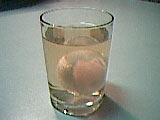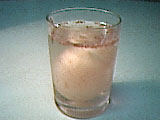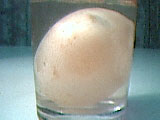


|
The nude egg
Science at Home |
||
|
Materials
|
Compounds
|
Videos:
Pictures: 


|
|
Procedure
1. Fill half of the total volume of a glass with vinegar. 2. Put the egg inside the glass. What do you observe? (add more vinegar if it doesn't cover the egg totally) 3. Observe the bubbles of gas that are formed in the surface of egg. 4. Observe periodically what happens in the next hours. 5. After one day you will be able to verify that the egg is completely nude and is larger than before. |
||
|
Why?
Now you know how to remove the egg peel without breaking it. The peel of the egg is made off calcium carbonate and the vinegar is a diluted solution of acetic acid. In the present experiment, the acetic acid reacts with the carbonate of calcium contained in the peel of the egg, producing carbon dioxide. The reaction is faster in the initial instants because the reagents are in maxim concentration. |
||
 |
No part of this website can be reproduced without previous authorization. Please inform me if there is any problem with the website. |